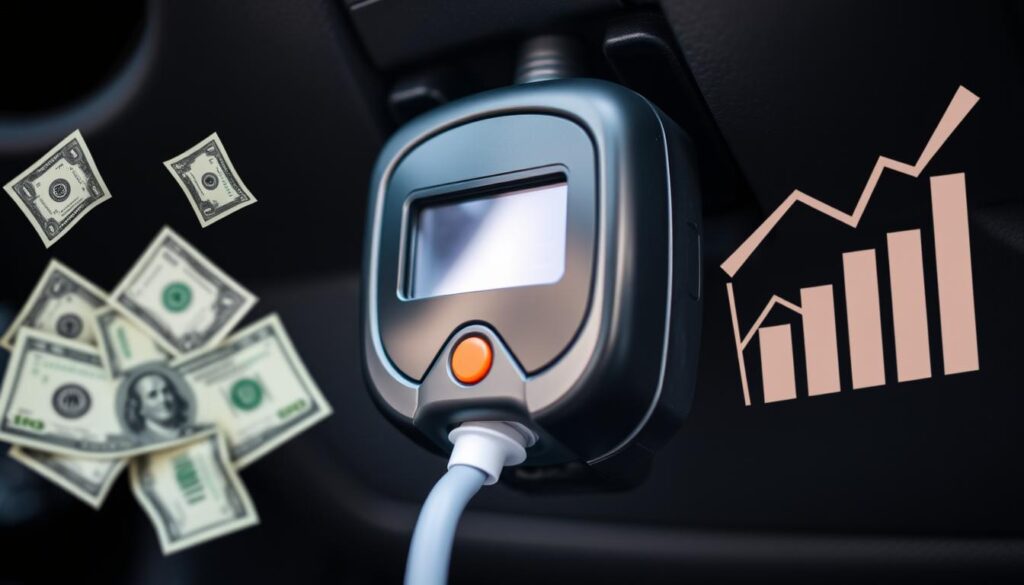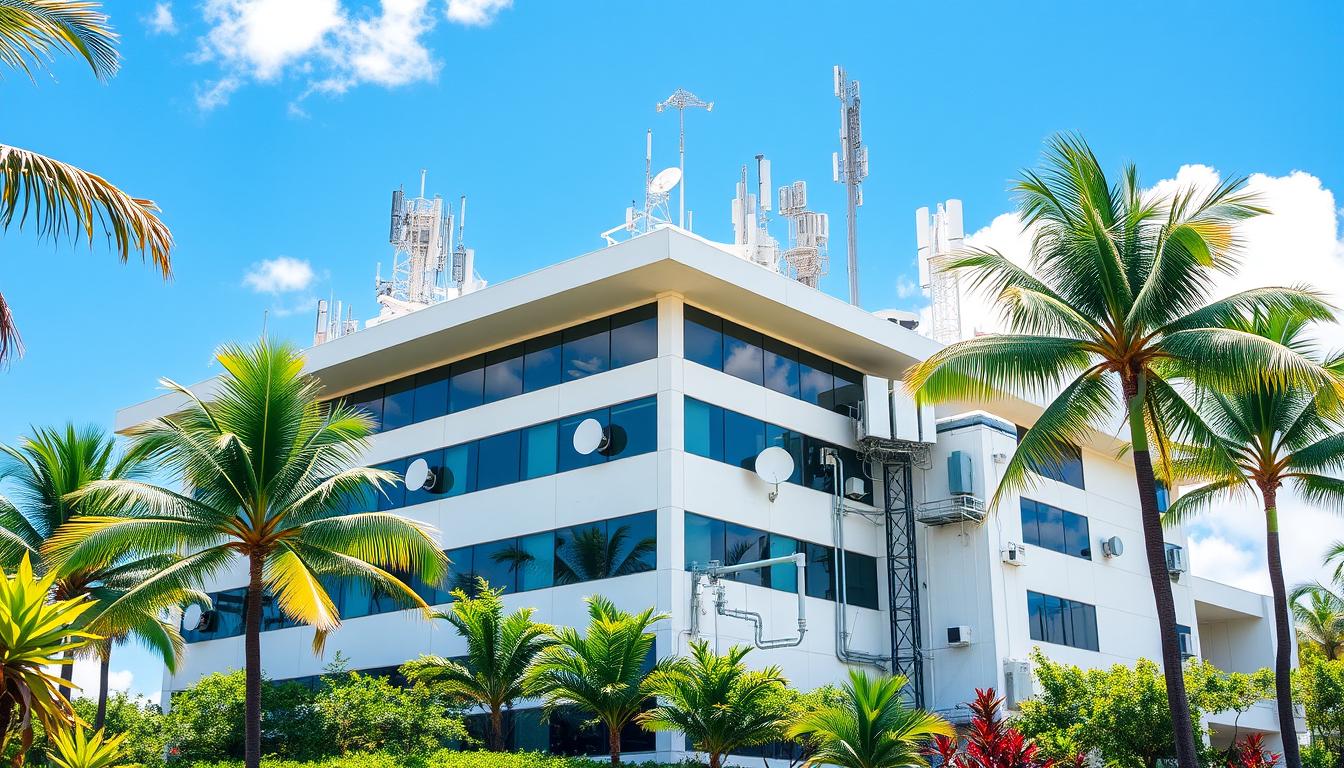If you’ve been charged with a DUI, you might need an ignition interlock device. These systems help stop you from driving drunk. But, you’re probably wondering, “How much does it cost?”

The price of an ignition interlock device changes based on several things. This includes the type of device and the state’s rules. In this guide, we’ll look at all the costs involved. This way, you’ll know what to expect financially.
Key Takeaways
- Ignition interlock devices are court-mandated for DUI offenders to prevent repeat offenses.
- The cost of installation and maintenance can vary widely depending on location and specific requirements.
- Factors that influence the cost include the type of device, installation fees, monthly monitoring fees, and potential violation charges.
- Some states offer financial assistance programs to help offset the costs for eligible individuals.
- It’s important to choose a reliable provider and understand all associated expenses before installation.
Understanding Ignition Interlock Devices and Their Purpose
Ignition interlock devices, or breathalyzer car systems, play a key role in preventing DUIs. They are alcohol detection devices that stop a vehicle from starting if alcohol is detected. This is to keep drivers safe and prevent accidents.
How Ignition Interlock Systems Work
These systems require a breath sample before starting the car. They check the breath to see if alcohol is present. If alcohol is found, the car won’t start.
Legal Requirements for Installation
In many places, you must have an ignition interlock device after a DUI or DWI conviction. This law helps keep roads safe and lowers alcohol-related accidents.
Benefits of Ignition Interlock Devices
These devices help lower the number of DUIs. By stopping drunk drivers, they greatly improve road safety. They are a crucial part of DUI prevention.
“Ignition interlock devices have been instrumental in reducing the number of alcohol-related crashes and saving lives on our roads.”
Initial Installation Costs and Basic Pricing
Installing an ignition interlock device comes with upfront costs. The ignition interlock installation fee is the main cost. It includes the device and the labor needed for installation. Prices for the device range from $70 to $150, with installation fees between $50 and $100.
The costs can change based on the provider, location, and extra features. Some providers offer financing or payment plans. This helps spread out the initial costs over time.
| Provider | Device Pricing | Installation Fee |
|---|---|---|
| Intoxalock | $70 – $150 | $50 – $100 |
| Smart Start | $70 – $150 | $50 – $100 |
It’s key to compare ignition interlock installation fee and device pricing from different providers. This ensures you get the best value and a smooth installation.
Monthly Maintenance and Monitoring Fees
Having an ignition interlock device costs more than just the setup. Drivers need to think about monthly fees and calibration costs. These can range from $60 to $100 each month, depending on where you live and who you get it from.
Regular Calibration Expenses
There’s also the cost of regular calibrations. States usually require these every 30 to 60 days. Each visit can cost between $50 to $100.
Data Download and Reporting Costs
Providers must download data and report it to authorities regularly. Some include this in the monthly fee. Others charge extra, from $10 to $30 a month.
Violation Reset Charges
If the device finds any issues, like a failed test, there’s a reset fee. These can cost between $25 to $75, plus any state penalties.
Drivers should really look into the ignition interlock maintenance cost before getting one. Knowing the monthly fees and calibration expenses helps manage costs. This way, you can use the device successfully and follow the rules.
| Expense | Average Cost |
|---|---|
| Ignition Interlock Maintenance Cost | $60 – $100 per month |
| Calibration Expenses | $50 – $100 per visit |
| Data Download and Reporting | $10 – $30 per month |
| Violation Reset Charges | $25 – $75 per violation |
“Budgeting for the ongoing costs of an ignition interlock device is crucial to ensure a successful and compliant experience.”
Additional Costs and Hidden Expenses
Ignition interlock devices come with more than just monthly fees. There are extra costs and hidden fees that can surprise drivers. These can make the total cost of the device much higher.
One big issue is early termination fees. If you need to remove the device early, you might face big penalties. Also, damage or tampering charges can add up fast, even if it was an accident.
Failed breath tests can also cost extra. If you fail to pass a test, you might have to pay for the device to be reset. This adds to the monthly costs.
- Early termination fees
- Device damage or tampering charges
- Fees for failed breath tests and device resets
Drivers should know the full cost of an ignition interlock device. This includes any extra or hidden fees. Knowing these costs helps drivers plan and manage their expenses better.

“The true cost of an ignition interlock device goes beyond the monthly fees. Drivers need to be aware of the potential for additional expenses that can quickly add up and impact their financial well-being.”
How Much Does It Cost to Have Ignition Interlock Installed in Different States
The cost of an ignition interlock device varies by state. This is because of different ignition interlock state laws and rules. Knowing these cost variations is key for those who must use these devices, often due to DUI convictions.
State-by-State Cost Comparison
Installation and monthly fees for these devices range from $50 to over $200. For example, in California, it costs about $70-$100 to install and $60-$80 a month to monitor. In Texas, the costs are $75-$150 for installation and $60-$100 a month.
Financial Assistance Programs
Some states offer financial aid for interlock devices to help with costs. New Mexico has an Indigent Fund for those who can’t afford it. Illinois also has a program for low-income offenders to cover the device’s cost.
Insurance Impact and Costs
Getting an ignition interlock device can also raise insurance premiums. In some places, insurance covers the device’s cost. In others, you must pay for it yourself. It’s important to check the insurance rules and costs in your state.
“The cost of an ignition interlock device can be a significant financial burden, but understanding the state-specific regulations and available assistance programs can help mitigate the expense.”
Choosing a Reliable Ignition Interlock Provider
Choosing the right ignition interlock provider is key to your safety and device effectiveness. The best ignition interlock companies offer reliable devices and top-notch customer service. They support you every step of the way.
LifeSafer is a top name for its focus on device reliability and customer service. Draeger is also well-liked for its trusted ignition interlock solutions.
When picking a provider, look at device accuracy, customer service support, and pricing clarity. Good companies share detailed info on their products, installation, and upkeep needs.
| Provider | Device Reliability | Customer Service | Pricing Transparency |
|---|---|---|---|
| LifeSafer | Excellent | Responsive and Helpful | Clear and Upfront |
| Draeger | Dependable | Knowledgeable and Courteous | Detailed and Transparent |
Researching and comparing ignition interlock companies helps you make a smart choice. This ensures your safety and peace of mind during the process.
“Choosing the right ignition interlock provider is essential for maintaining the integrity of the device and ensuring a smooth and hassle-free experience.”
Duration Requirements and Long-term Cost Considerations
Installing an ignition interlock device can affect your wallet over time. The length of time you need it varies by state. It can range from 6 months to several years, based on the crime’s severity and local laws.
Minimum Installation Periods
The time you must use an ignition interlock device is key. It affects how much you’ll spend on it. Most states require a minimum time, which can be:
- 6 months for a first-time offense
- 1 year for a second offense
- Up to 5 years or more for multiple or more severe violations
The longer you need it, the more you’ll pay. This is because you’ll have to pay monthly fees for a longer time.
Early Removal Options
Some people might get to remove the device early. This happens if they meet certain conditions. These include:
- Maintaining a clean driving record during the installation period
- Consistently complying with the device’s requirements
- Demonstrating a commitment to responsible driving
Getting the device removed early can save you money. But, the rules for this vary by state. It’s wise to talk to a local provider or lawyer to learn more about your options and costs.
Knowing about the time needed and early removal options can help you plan. This way, you can manage the costs of an ignition interlock device better. Being informed helps you make smart choices and handle the financial side of this safety measure.
Common Problems and Associated Repair Costs
Ignition interlock devices are made to be reliable and easy to use. But, sometimes they can malfunction. It’s important to know about common problems and their repair costs if you have one installed.
Ignition interlock malfunctions are a common issue. These can include sensor errors or power supply problems. The cost to fix these can vary a lot. Luckily, many makers offer warranties that cover some malfunctions, which can help lower your costs.
Another issue is the need for device repairs. Over time, parts of the ignition interlock system can wear out or get damaged. Replacing or fixing these parts can cost anywhere from a few dollars to hundreds of dollars.
Users might also have to pay for troubleshooting expenses if the device isn’t working right. This could mean paying for technical support, diagnostic tests, or even getting to and from the service center. While these costs might seem high, they’re often needed to keep the device working right and to follow the law.

Knowing about possible problems and their costs can help drivers with ignition interlock devices. They can prepare for and handle any unexpected expenses. Regular maintenance and quick troubleshooting can also help reduce the impact of these issues. This ensures a smooth and legal experience with the device.
Conclusion
The cost of an ignition interlock device varies a lot. It depends on where you live, the provider, and your case’s needs. But, it’s key to budget for the ignition interlock cost to follow the law and drive safely after a DUI.
The DUI financial impact is big, but the benefits of an ignition interlock are greater. These devices keep drunk drivers off the road. They help keep everyone safe and let drivers show they can drive responsibly.
Choosing to use an ignition interlock is a personal choice. But knowing the budgeting for interlock device costs is important. This way, you can make smart choices and move forward with your life.
FAQ
What is the purpose of an ignition interlock device?
An ignition interlock device is a breathalyzer in your car. It stops the engine if it finds alcohol on your breath. It’s for people who have driven under the influence to keep them safe and prevent accidents.
How much does it typically cost to have an ignition interlock device installed?
The cost to install one varies by state and provider. The initial fee is between $70 to $150. Monthly fees are $60 to $100.
What are the ongoing maintenance and monitoring fees associated with an ignition interlock device?
There are ongoing fees for upkeep and monitoring. These include calibration costs of $50 to $100 every 30-60 days. Monthly data download and reporting fees are $10 to $50. There might also be charges for device resets due to violations.
Are there any additional or hidden costs to consider with an ignition interlock device?
Yes, there are extra costs. These include early termination fees up to $200 and damage charges up to $150. There are also costs for failed tests or lockouts, up to $100 each.
How do the costs of ignition interlock devices vary across different states?
Costs vary by state due to different laws. Some states, like New Mexico, offer financial help. Others might have higher costs. Always check your state’s rules and prices.
How can I choose a reliable ignition interlock provider?
Look for a provider known for accurate devices and good customer service. Companies like LifeSafer, Draeger, and Intoxalock are known for their quality and reliability.
What are the typical duration requirements for having an ignition interlock device installed?
The time you need to have one installed varies by state and offense severity. It’s usually 6 months to 1 year. But, some cases might allow for early removal.
What are some common problems and associated repair costs with ignition interlock devices?
Issues include malfunctions and calibration errors. Repair costs are $50 to $150. Fixing problems quickly is key to avoid penalties.



